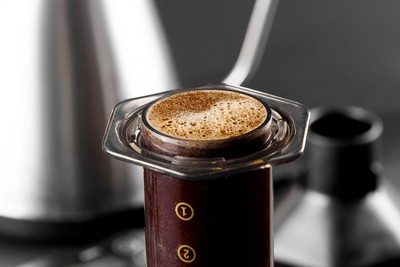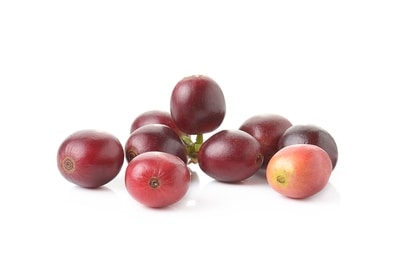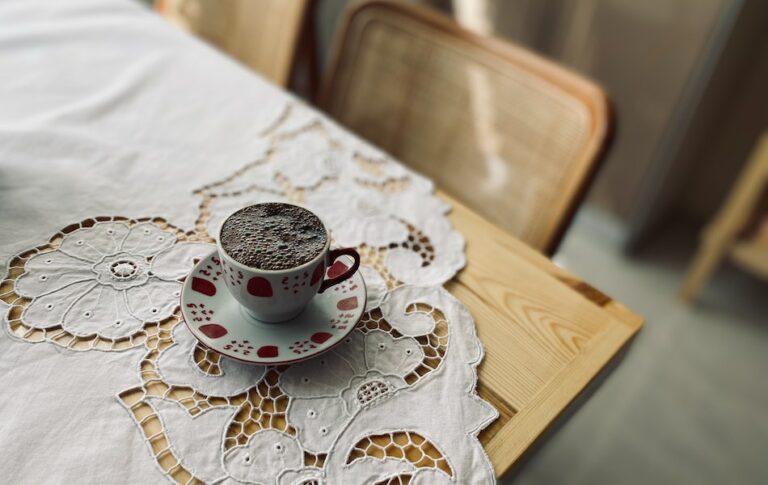Should I Buy an AeroPress?
Many of us have grown up with and enjoyed French press or Italian moka pot coffee. But there’s a new kid on the block: the AeroPress. You’ve heard about it and you think you want one, but should you buy an AeroPress?
The AeroPress makes delicious coffee quickly. It’s made from BPA-free plastic meaning it’s also unbreakable. You can make your coffee the way you like it as AeroPress recipes are so diverse. It’s proven how good it is by its popularity around the world.
This guide breaks down all the positives and negatives for you to decide whether or not to buy the AeroPress.

Why buy an AeroPress?
- Quick brewing
- Solid construction
- Cheap filters
- Extra goodies
- Small and compact
- Portability
- Easy to clean (and dishwasher safe)
- Versatility
- Inexpensive
- Cold brew
- Used by the pros
- Aftermarket accessories
Why not buy an AeroPress?
- One size
- Pre-heating
- Finicky
The positives
1. Quick brewing
Brew time can be as little as one minute. Because the AeroPress accepts such a wide range of grind sizes, it can make a cup of coffee extremely quickly.
If you’re after a coffee in a hurry, you can grind to almost espresso fineness and you’ll be enjoying your cup after just one minute.
2. Solid construction
The plastic construction is pretty much unbreakable. I can’t remember how many French presses I’ve smashed over the years. No matter how careful I am, I always manage to shatter the glass sooner or later. Breakages are not a concern with the AeroPress.
It’ll definitely outlast the mostly awful French press filters which become misshapen over time, resulting in more and more coffee grounds passing through. For a better French press experience, check out the Espro Press.
The AeroPress is also made from food-grade plastic (BPA- and phthalate-free). Just make sure that you buy a genuine AeroPress and not a cheap, Chinese imitation which may use dangerous plastics.
3. Cheap filters
The AeroPress uses small paper filters so there’s no sediment in your cup. This results in a smooth and clean cup of coffee. Paper filters can be expensive, but the AeroPress filters are definitely the cheapest filters on the market. They’re around £5 ($6) for a whopping 350 filters.
A lot of paper filters are pretty thick and need a good rinsing to avoid imparting a papery taste in the brew. AeroPress filters are incredibly thin, so much so that some don’t even rinse before brewing.
If you enjoy the body that you get from the coffee oils when you use a French press filter, you can buy an aftermarket metal filter for the AeroPress. Keep reading to find out more on aftermarket accessories.
4. Extra goodies
The AeroPress package comes complete with measuring spoon, funnel, paddle, and a holder for your paper filters.
5. Small and compact
The compact size is great if space is at a premium at home, work, or when travelling.
6. Portability
Due to its compact size and plastic construction, it’s the perfect brewer for travelling.
If space is really at a premium, you can always replace the paper filters with an aftermarket, reusable metal filter.
If you grind whole beans, you can even fit a Rhino hand grinder inside the AeroPress for the ultimate, transportable, compact coffee set-up.
The numbers on the side of the AeroPress allow you to judge how much water you’re adding for repeatability.
We always recommend using scales to brew your coffee; however, it’s not always practical to carry around a scale with you when you’re out on the road.
7. Easy to clean (and dishwasher safe)
The clean up is one of the best things about the AeroPress. It’s so much easier to clean than a French press or an Italian moka pot. After you finish brewing, fully depress the plunger, unscrew the cap, and slide the compact coffee puck into the bin.
Many people just rinse their AeroPress after use, but we always recommend using soap. The flavour of stale coffee isn’t nice, so take an extra 30 seconds to give it a quick scrub with washing up liquid. There are only three parts, after all.
The AeroPress is also dishwasher safe. The manufacturer recommends cleaning it on the top shelf of your dishwasher. However, I would advise against cleaning the AeroPress in the dishwasher as the plastic construction takes on the odours of the dishwasher tablets.
8. Versatility
The AeroPress is so versatile compared to the French press and Italian moka pot for creating different flavour profiles with your coffee.
You can use a quick brew, a long brew, fine grind, coarse grind, cool water, hot water, quick plunge, slow plunge. The AeroPress was made to be played with – a toy for adults!
9. Inexpensive
The AeroPress is good value at around £30 (or $30 in US). It’ll last you a really long time before you have to buy any replacement parts.
The AeroPress rubber seal is good for around 1000 cups of coffee, and when it comes to replacing, it’s only £7 ($8).
10. Cold brew
You can make cold brew in just two minutes. Yes, two minutes! No more having to leave your coffee for 12 – 24 hours to extract the flavours. Read on to find out how.
Cold brew is great for a summer’s day, for batch brewing, or if you prefer bitter-free coffee.
11. Used by the pros
The AeroPress is used all over the world and is particularly popular in uber-cool Scandinavia.
This thing is so popular that there’s even a World Aeropress Championship (WAC) held every year.
Barista and roaster Tim Wendelboe (World Barista Champion 2004) and friends liked the AeroPress’s versatility so much that they held a private competition at the Tim Wendelboe café in Oslo, Norway.
From what started with just three friends in a private room in a café has turned into a worldwide event. Countries all around the globe hold their own annual championships with the winners going onto the WAC.
12. Aftermarket accessories
Reusable metal filters: If you enjoy the body you get from a French press or Italian moka pot, then you don’t have to use paper filters.
Paper doesn’t just prevent the coffee grounds from passing but also the oils inherent in the coffee. Those oils are what contribute to that mouthfeel and body you enjoy from your French press.
Aftermarket, reusable mesh metal filters are widely available on Amazon or eBay for as little as £3 ($4). For best quality, check out this metal filter by Able Brewing.
Metal filters are also perfect for when you’re transporting your AeroPress around and space is at a premium. No need for extra space to store your paper filters. Just store your reusable metal filter inside the AeroPress cap.
Fellow Prismo: The pressure-actuated valve cap contains a reusable, 70-micron metal filter and is designed to produce espresso-style coffee using the AeroPress. It also creates a no-drip seal, so no need to use the inverted method for brewing.
Able travel cap: Along with their disk filter, Able Brewing has also invented a plastic lid to place at the end of the AeroPress plunger. Fill the plunger with fresh coffee for ultimate portability.
The negatives
1. One size
A big drawback compared to a French press or an Italian moka pot is that the AeroPress only comes in one size. People that enjoy drinking lots of coffee find this pretty annoying. But there is a workaround.
You can make up to four cups of coffee with the AeroPress by making a concentrated brew. You’ll need to use a high coffee to water ratio which you can then dilute with freshly boiled water.
It’s actually a great way to enjoy fresh coffee throughout the day rather than making a batch and having to reheat it in the microwave later on.
2. Pre-heating
People also worry about the plastic construction not having any heat retention. Whilst it’s true that it’s difficult to preheat the AeroPress, the plastic construction is actually great for thermodynamics.
You see, a ceramic, glass or metal brewer sucks around 13% of the initial water temperature. Plastic only robs you of about 7%. This means that the liquid inside your AeroPress is staying hotter for longer, resulting in a better brew.
3. Finicky
It’s not difficult to make AeroPress coffee, but there are definitely more variables involved when compared to a French press. You can’t go forgetting it whilst brewing.
But don’t see this as a negative. As you progress in your coffee making, you’ll start to enjoy how you can play with your coffee using the AeroPress. Heighten or lower the sweetness, the acidity, the body. Use a fine grind for quick brews (including cold brew), or a coarse grind for slower brews.
You’ll need to apply a bit of pressure to the plunger to produce your cup of coffee, too. Something to think about if you’re not too steady on your feet due to health issues.
Enjoying this article? Ever wondered what Colombian coffee is? Have a read of my article to find out.
What’s the difference between an AeroPress and a French press?
AeroPress:
- Paper filter (aftermarket metal filters available)
- Easy to clean
- Durable
- Less forgiving
- Versatile
- Quick brew time
French press
- Metal filter
- Easy to use
- Hard to clean
- Easy to break
- Muddled taste
- Consistent
- Long brew time
Does the AeroPress make espresso?
The short answer is no, the AeroPress does not make espresso. People confuse strong, concentrated coffee with espresso. You can definitely achieve a highly concentrated brew with the Aeropress, but it’s not espresso. Why?
The definition of the Italian word espresso is ‘pressed out’. You certainly do press an AeroPress to filter your brew, but with nothing like the force espresso machines use. At most, you’ll achieve around 0.75 of a bar of pressure plunging an AeroPress.
Espresso machines force water through coffee using around nine bars of pressure. You can’t produce that kind of force by hand, so you can’t produce espresso. Don’t be fooled by the blogs and videos that say you can produce espresso.
Some people call espresso-style AeroPress coffee aeropresso. To make a concentrated aeropresso coffee, use a coffee to water ratio of 1:2, tamping the finely ground coffee with a filter on top of the coffee bed to create extra pressure.
You can also up the pressure by using an aftermarket Fellow Prismo filter cap, which we’ll talk about in a bit.
AeroPress recipes are endless
While this can seem a little daunting, it doesn’t have to be. You can use your AeroPress like you do your French press. Add your coffee, pour in your water, a gentle stir, leave to brew, plunge.
Once you’ve got that down, you can look at playing with the AeroPress if you want to. But don’t worry yourself. Making a AeroPress coffee is a lot like cooking: sometimes the best way to learn is by making mistakes.
Start with the basics and get more and more adventurous over time.
Cold brew and iced coffee

Because the AeroPress is a full-immersion brewer, it’s great for cold brew and iced coffee.
Two-minute cold brew
You can make cold brew coffee in two minutes with the AeroPress.
- 20g finely ground coffee
- Pour in 60g room-temperature water
- Stir vigorously for 60 seconds
- Press
- Dilute with ice-cold water
See my guide on how to make cold brew using a range of coffee brewing devices.
Instant iced coffee
Grind finer than you normally would or brew for longer. Use a coffee to water ratio of 1:8.
- 20g finely ground coffee
- 160g hot water
- Stir gently and leave for 1:30′
- Plunge over a sturdy glass filled with ice for instant iced coffee
Alternatives to the AeroPress
Clever Dripper
If you’re still not convinced (gasp!), then my other recommendation is the Clever Dripper. This is a brilliant entry-level coffee brewer.
It’s just like the French press but with an easier cleanup and a smoother and cleaner taste due to the paper filter. It’s plastic too, so no worries about having to replace it because of breakages.
Delter Coffee Press
Up until recently, the AeroPress was fairly unique. That was until the Delter Coffee Press came along with their take on this amazing brewer.
You’ll be forgiven for thinking that it’s just a copy, but it isn’t. The Delter Press works in quite a different way. The AeroPress is an immersion brewer, but the Delter Press combines immersion with pour-over. It is a lot more fiddly to use, however. Check out James Hoffmann’s review on YouTube.
Conclusion
Yes, you should buy one. I have three, but I’m not lending you mine. Do you and your coffee a massive favour and check out the price on Amazon right now.
Did you enjoy this article? Find out all about how Nestlé makes instant coffee in my fascinating article.







